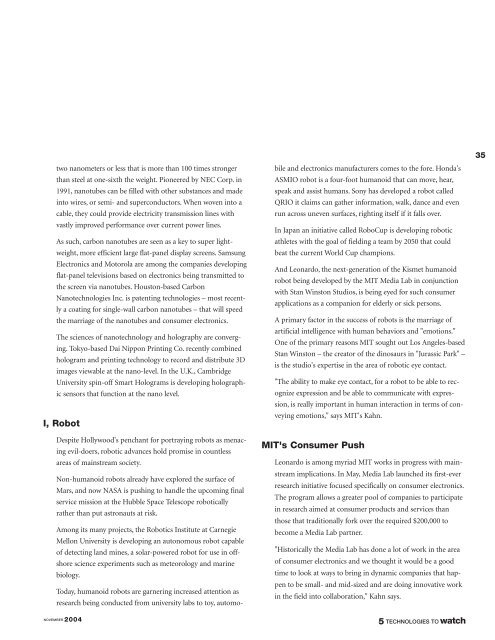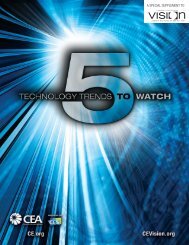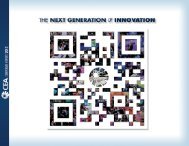TECHNOLOGIES TO watch - Consumer Electronics Association
TECHNOLOGIES TO watch - Consumer Electronics Association
TECHNOLOGIES TO watch - Consumer Electronics Association
You also want an ePaper? Increase the reach of your titles
YUMPU automatically turns print PDFs into web optimized ePapers that Google loves.
35<br />
NOVEMBER 2004<br />
two nanometers or less that is more than 100 times stronger<br />
than steel at one-sixth the weight. Pioneered by NEC Corp. in<br />
1991, nanotubes can be filled with other substances and made<br />
into wires, or semi- and superconductors. When woven into a<br />
cable, they could provide electricity transmission lines with<br />
vastly improved performance over current power lines.<br />
As such, carbon nanotubes are seen as a key to super lightweight,<br />
more efficient large flat-panel display screens. Samsung<br />
<strong>Electronics</strong> and Motorola are among the companies developing<br />
flat-panel televisions based on electronics being transmitted to<br />
the screen via nanotubes. Houston-based Carbon<br />
Nanotechnologies Inc. is patenting technologies – most recently<br />
a coating for single-wall carbon nanotubes – that will speed<br />
the marriage of the nanotubes and consumer electronics.<br />
The sciences of nanotechnology and holography are converging.<br />
Tokyo-based Dai Nippon Printing Co. recently combined<br />
hologram and printing technology to record and distribute 3D<br />
images viewable at the nano-level. In the U.K., Cambridge<br />
University spin-off Smart Holograms is developing holographic<br />
sensors that function at the nano level.<br />
I, Robot<br />
Despite Hollywood's penchant for portraying robots as menacing<br />
evil-doers, robotic advances hold promise in countless<br />
areas of mainstream society.<br />
Non-humanoid robots already have explored the surface of<br />
Mars, and now NASA is pushing to handle the upcoming final<br />
service mission at the Hubble Space Telescope robotically<br />
rather than put astronauts at risk.<br />
Among its many projects, the Robotics Institute at Carnegie<br />
Mellon University is developing an autonomous robot capable<br />
of detecting land mines, a solar-powered robot for use in offshore<br />
science experiments such as meteorology and marine<br />
biology.<br />
Today, humanoid robots are garnering increased attention as<br />
research being conducted from university labs to toy, automobile<br />
and electronics manufacturers comes to the fore. Honda's<br />
ASMIO robot is a four-foot humanoid that can move, hear,<br />
speak and assist humans. Sony has developed a robot called<br />
QRIO it claims can gather information, walk, dance and even<br />
run across uneven surfaces, righting itself if it falls over.<br />
In Japan an initiative called RoboCup is developing robotic<br />
athletes with the goal of fielding a team by 2050 that could<br />
beat the current World Cup champions.<br />
And Leonardo, the next-generation of the Kismet humanoid<br />
robot being developed by the MIT Media Lab in conjunction<br />
with Stan Winston Studios, is being eyed for such consumer<br />
applications as a companion for elderly or sick persons.<br />
A primary factor in the success of robots is the marriage of<br />
artificial intelligence with human behaviors and "emotions."<br />
One of the primary reasons MIT sought out Los Angeles-based<br />
Stan Winston – the creator of the dinosaurs in "Jurassic Park" –<br />
is the studio's expertise in the area of robotic eye contact.<br />
"The ability to make eye contact, for a robot to be able to recognize<br />
expression and be able to communicate with expression,<br />
is really important in human interaction in terms of conveying<br />
emotions," says MIT's Kahn.<br />
MIT's <strong>Consumer</strong> Push<br />
Leonardo is among myriad MIT works in progress with mainstream<br />
implications. In May, Media Lab launched its first-ever<br />
research initiative focused specifically on consumer electronics.<br />
The program allows a greater pool of companies to participate<br />
in research aimed at consumer products and services than<br />
those that traditionally fork over the required $200,000 to<br />
become a Media Lab partner.<br />
"Historically the Media Lab has done a lot of work in the area<br />
of consumer electronics and we thought it would be a good<br />
time to look at ways to bring in dynamic companies that happen<br />
to be small- and mid-sized and are doing innovative work<br />
in the field into collaboration," Kahn says.<br />
5 <strong>TECHNOLOGIES</strong> <strong>TO</strong> <strong>watch</strong>










